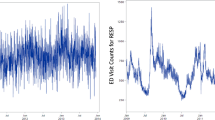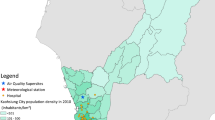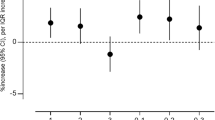Abstract
Elemental carbon (EC) and organic carbon (OC) represent a substantial portion of particulate matter <2.5 μm in diameter (PM2.5), and have been associated with adverse health effects. EC and OC are commonly measured using the National Institute of Occupational Safety and Health (NIOSH) method or the Interagency Monitoring of Protected Visual Environments (IMPROVE) method. Measurement method differences could have an impact on observed epidemiologic associations. Daily speciated PM2.5 data were obtained from the St Louis-Midwest Supersite, and St Louis emergency department (ED) visit data were obtained from the Missouri Hospital Association for the period June 2001 to April 2003. We assessed acute associations between cardiorespiratory ED visits and EC and OC from NIOSH and IMPROVE methods using Poisson generalized linear models controlling for temporal trends and meteorology. Associations were generally similar for EC and OC from the different measurement methods. The most notable difference between methods was observed for congestive heart failure and EC (for example, warm season rate ratios (95% confidence intervals) per interquartile range change in EC concentration were: NIOSH=1.06 (0.99–1.13), IMPROVE=1.01 (0.96–1.07)). Overall, carbon measurement method had little impact on acute associations between EC, OC, and ED visits. Some specific differences were observed, however, which may be related to particle composition.
This is a preview of subscription content, access via your institution
Access options
Subscribe to this journal
Receive 6 print issues and online access
$259.00 per year
only $43.17 per issue
Buy this article
- Purchase on SpringerLink
- Instant access to full article PDF
Prices may be subject to local taxes which are calculated during checkout

Similar content being viewed by others
References
Bell ML, Dominici F, Ebisu K, Zeger SL, Samet JM . Spatial and temporal variation in PM2.5 chemical composition in the United States for health effects studies. Environ Health Perspect 2007; 115: 989–995.
Levy JI, Diez D, Dou Y, Barr CD, Dominici F . A Meta-analysis and multisite time-series analysis of the differential toxicity of major fine particulate matter constituents. Am J Epidemiol 2012; 175: 1091–1099.
Rohr AC, Wyzga RE . Attributing health effects to individual particulate matter constituents. Atmos Environ 2012; 62: 130–152.
Kelly FJ, Fussell JC . Size, source and chemical composition as determinants of toxicity attributable to ambient particulate matter. Atmos Environ 2012; 60: 504–526.
Chow JC, Watson JG, Pritchett LC, Pierson WR, Frazier CA, Purcell RG . The DRI thermal optical reflectance carbon analysis system - Description, evaluation and applications in United-States air-quality studies. Atmos Environ Part A-General Topics 1993; 27: 1185–1201.
Schmid H, Laskus L, Abraham HJ, Baltensperger U, Lavanchy V, Bizjak M et al. Results of the ‘‘carbon conference’’ international aerosol carbon round robin test stage I. Atmos Environ 2001; 35: 2111–2121.
Bae MS, Schauer JJ, Turner JR, Hopke PK . Seasonal variations of elemental carbon in urban aerosols as measured by two common thermal-optical carbon methods. Sci Total Environ 2009; 407: 5176–5183.
Birch ME, Cary RA . Elemental carbon-based method for occupational monitoring of particulate diesel exhaust: Methodology and exposure issues. Analyst 1996; 121: 1183–1190.
Schauer JJ, Mader BT, Deminter JT, Heidemann G, Bae MS, Seinfeld JH et al. ACE-Asia intercomparison of a thermal-optical method for the determination of particle-phase organic and elemental carbon. Environ Sci Technol 2003; 37: 993–1001.
Peterson MR, Richards MH . Thermal-optical-transmittance analysis for organic, elemental, carbonate, total carbon, and OCX2 in PM2.5 by the EPA/NIOSH Method- #83: Research Triangle Institute: Research Triangle Park, NC, 2002. Available at http://www.rti.org/pubs/OC-EC_Paper_83_3b.pdf. Accessed 23 December 2013.
Chow JC, Watson JG, Chen LWA, Chang MCO, Robinson NF, Trimble D et al. The IMPROVE-A temperature protocol for thermal/optical carbon analysis: maintaining consistency with a long-term database. J Air Waste Manag Assoc 2007; 57: 1014–1023.
Bae MS, Schauer JJ, DeMinter JT, Turner JR, Smith D, Cary RA . Validation of a semi-continuous instrument for elemental carbon and organic carbon using a thermal-optical method. Atmos Environ 2004; 38: 2885–2893.
Cheng Y, Zheng M, He KB, Chen Y, Yan B, Russell AG et al. Comparison of two thermal-optical methods for the determination of organic carbon and elemental carbon: Results from the southeastern United States. Atmos Environ 2011; 45: 1913–1918.
U.S. Environmental Protection Agency. PM2.5 Speciation network newsletter, Issue 6 (Summer 2009). U.S. EPA Office of Air Quality Planning and Standards, Air Quality Assessment Division: Research Triangle Park, NC, 2009. Available at http://www.epa.gov/ttn/amtic/files/ambient/pm25/spec/spnews6.pdf. Accessed 23 December 2013.
Chow JC, Watson JG, Chen LWA, Arnott WP, Moosmuller H . Equivalence of elemental carbon by thermal/optical reflectance and transmittance with different temperature protocols. Environ Sci Technol 2004; 38: 4414–4422.
Cheng Y, Duan FK, He KB, Zheng M, Du ZY, Ma YL et al. Intercomparison of thermal-optical methods for the determination of organic and elemental carbon: influences of aerosol composition and implications. Environ Sci Technol 2011; 45: 10117–10123.
Cheng Y, He KB, Duan FK, Zheng M, Ma YL, Tan JH et al. Improved measurement of carbonaceous aerosol: evaluation of the sampling artifacts and inter-comparison of the thermal-optical analysis methods. Atmos Chem Phys 2010; 10: 8533–8548.
Khan B, Hays MD, Geron C, Jetter J . Differences in the OC/EC ratios that characterize ambient and source aerosols due to thermal-optical analysis. Aerosol Sci Technol 2012; 46: 127–137.
Turner JR . St Louis—Midwest fine particulate matter supersite: revised final report. 2007. Available at ftp://narsto.esd.ornl.gov/pub/EPA_Supersites/stl/AIR_CHEM_PM_MET/STL-SS_FinalReport_Rev02_March2007.pdf. Accessed 23 December 2013.
Lee JH, Hopke PK, Turner JR . Source identification of airborne PM2.5 at the St Louis-Midwest Supersite. J Geophys Res 2006; 111: D10S10.
Marple VA, Rubow KL, Turner W, Spengler JD . Low flow-rate sharp cut impactors for indoor air sampling - design and calibration. JAPCA 1987; 37: 1303–1307.
Bae MS, Schauer JJ, DeMinter JT, Turner JR . Hourly and daily patterns of particle-phase organic and elemental carbon concentrations in the urban atmosphere. J Air Waste Manage Assoc 2004; 54: 823–833.
US Environmental Protection Agency. National Ambient Air Quality Standards (NAAQS) Web site. Available at http://www.epa.gov/air/criteria.html. Accessed 21 March 2014.
Ostro B, Roth L, Malig B, Marty M . The effects of fine particle components on respiratory hospital admissions in children. Environ Health Perspect 2009; 117: 475–480.
Peng RD, Bell ML, Geyh AS, McDermott A, Zeger SL, Samet JM et al. Emergency admissions for cardiovascular and respiratory diseases and the chemical composition of fine particle air pollution. Environ Health Perspect 2009; 117: 957–963.
Ostro B, Feng WY, Broadwin R, Green S, Lipsett M . The effects of components of fine particulate air pollution on mortality in California: Results from CALFINE. Environ Health Perspect 2007; 115: 13–19.
Mar TF, Norris GA, Koenig JQ, Larson TV . Associations between air pollution and mortality in Phoenix, 1995-1997. Environ Health Perspect 2000; 108: 347–353.
Sinclair AH, Edgerton ES, Wyzga R, Tolsma D . A two-time-period comparison of the effects of ambient air pollution on outpatient visits for acute respiratory illnesses. J Air Waste Manag Assoc 2010; 60: 163–175.
Strickland MJ, Darrow LA, Klein M, Flanders WD, Sarnat JA, Waller LA et al. Short-term associations between ambient air pollutants and pediatric asthma emergency department visits. Am J Respir Crit Care Med 2010; 182: 307–316.
Cao J, Xu H, Xu Q, Chen B, Kan H . Fine particulate matter constituents and cardiopulmonary mortality in a heavily polluted Chinese city. Environ Health Perspect 2012; 120: 373–378.
Peel JL, Tolbert PE, Klein M, Metzger KB, Flanders WD, Todd K et al. Ambient air pollution and respiratory emergency department visits. Epidemiology 2005; 16: 164–174.
Sarnat JA, Marmur A, Klein M, Kim E, Russell AG, Sarnat SE et al. Fine particle sources and cardiorespiratory morbidity: An application of chemical mass balance and factor analytical source-apportionment methods. Environ Health Perspect 2008; 116: 459–466.
Tolbert PE, Klein M, Metzger KB, Peel J, Flanders WD, Todd K et al. Interim results of the study of particulates and health in Atlanta (SOPHIA). J Expo Anal Environ Epidemiol 2000; 10: 446–460.
Metzger KB, Tolbert PE, Klein M, Peel JL, Flanders WD, Todd K et al. Ambient air pollution and cardiovascular emergency department visits. Epidemiology 2004; 15: 46–56.
Delfino RJ, Staimer N, Tjoa T, Arhami M, Polidori A, Gillen DL et al. Associations of primary and secondary organic aerosols with airway and systemic inflammation in an elderly panel cohort. Epidemiology 2010; 21: 892–902.
Mills NL, Tornqvist H, Gonzalez MC, Vink E, Robinson SD, Soderberg S et al. Ischemic and thrombotic effects of dilute diesel-exhaust inhalation in men with coronary heart disease. N Engl J Med 2007; 357: 1075–1082.
Mills NL, Robinson SD, Fokkens PHB, Leseman DLAC, Miller MR, Anderson D et al. Exposure to concentrated ambient particles does not affect vascular function in patients with coronary heart disease. Environ Health Perspect 2008; 116: 709–715.
Turner JR, Yadav V, Feinberg SN . Data analysis and dispersion modeling for the midwest rail study (phase I): Final report. 2009. Available at http://www.ladco.org/reports/general/new_docs/WUSTL_MidwestRailStudy_FinalReport.pdf. Accessed 23 December 2013.
Rich DQ, Kim MH, Turner JR, Mittleman MA, Schwartz J, Catalano PJ et al. Association of ventricular arrhythmias detected by implantable cardioverter defibrillator and ambient air pollutants in the St Louis, Missouri metropolitan area. Occup Environ Med 2006; 63: 591–596.
Peng RD, Bell ML . Spatial misalignment in time series studies of air pollution and health data. Biostatistics 2010; 11: 720–740.
Zeger SL, Thomas D, Dominici F, Samet JM, Schwartz J, Dockery D et al. Exposure measurement error in time-series studies of air pollution: concepts and consequences. Environ Health Perspect 2000; 108: 419–426.
Tolbert PE, Klein M, Peel JL, Sarnat SE, Sarnat JA . Multipollutant modeling issues in a study of ambient air quality and emergency department visits in Atlanta. J Expo Sci Environ Epidemiol 2007; 17: S29–S35.
Acknowledgements
This publication was made possible by grants to Emory University from the Electric Power Research Institute (EP-25912/C12525) and the US Environmental Protection Agency (RD834799). Its contents are solely the responsibility of the grantee and do not necessarily represent the official views of the USEPA. Further, USEPA does not endorse the purchase of any commercial products or services mentioned in the publication.
Author information
Authors and Affiliations
Corresponding author
Ethics declarations
Competing interests
The authors declare no conflict of interest.
Additional information
Supplementary Information accompanies the paper on the Journal of Exposure Science and Environmental Epidemiology website
Supplementary information
Rights and permissions
About this article
Cite this article
Winquist, A., Schauer, J., Turner, J. et al. Impact of ambient fine particulate matter carbon measurement methods on observed associations with acute cardiorespiratory morbidity. J Expo Sci Environ Epidemiol 25, 215–221 (2015). https://doi.org/10.1038/jes.2014.55
Received:
Revised:
Accepted:
Published:
Issue date:
DOI: https://doi.org/10.1038/jes.2014.55
Keywords
This article is cited by
-
Ambient air pollution and emergency department visits for asthma: a multi-city assessment of effect modification by age
Journal of Exposure Science & Environmental Epidemiology (2016)
-
Organic and elemental carbon variation in PM2.5 over megacity Delhi and Bhubaneswar, a semi-urban coastal site in India
Natural Hazards (2016)
-
Current Methods and Challenges for Epidemiological Studies of the Associations Between Chemical Constituents of Particulate Matter and Health
Current Environmental Health Reports (2015)



